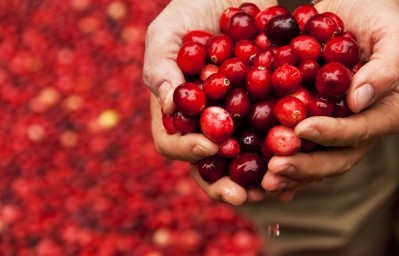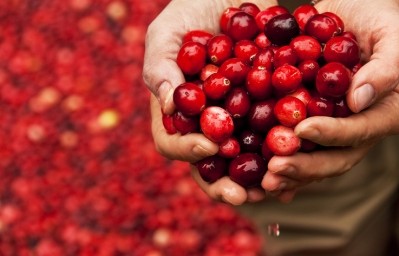Cranberry outperforms D-mannose in urinary tract health trial

The study, co-authored by cranberry expert Dr. Amy Howell, used a combination of in vitro bioassays and ex vivo urine analyses to compare the anti-adhesion activity of the two supplements in the same group of 20 participants.
“Following daily intake for a week, the cranberry fruit juice dry extract product with 36 mg PAC (proanthocyanidin) provided significantly greater urinary bacterial anti-adhesion activity over each 24-hour period than the D-mannose product against both P-type and Type 1 E. coli strains that cause UTIs,” Dr. Howell told NutraIngredients-USA.
The researchers used a 206 mg Gikacran (Vaccinium macrocarpon Ait.) cranberry juice concentrate extract manufactured as Ellura by Solv Wellness (serving size one capsule) and a 500 mg D-mannose capsule from NOW Foods (serving size three capsules), both purchased online.
Prophylactic power: Cranberry vs. D-mannose
According to a large-scale meta-analysis published in The Cochrane Database of Systematic Reviews in 2023, consumption of highly-standardized cranberry juice extract products can prevent and reduce the risk of recurrent UTIs in women, children and other at-risk individuals.
Dr. Howell highlighted that not all cranberry supplements are created equal when it comes to maintaining urinary tract health, with research to date supporting cranberry juice-based supplements standardized to 36 mg of PAC content as most effective.
“Many lower cost supplements contain the pomace fiber material left over after the juice is removed and are not as effective at preventing bacterial adhesion,” she explained. “The whole berry supplements have some juice, but higher intake would be needed compared to a pure juice-based product.”
The anti-adhesion activity of cranberry juice was discovered in 1984 by A.E. Sobota, disproving the theory that the acidity of cranberry was responsible for killing off the UTI-triggering bacteria. By the late 1990s, researchers had tied the PAC content to the in vitro activity, which then correlated with ex vivo activity in the urine following cranberry intake and against P-type uropathogenic E. coli.
“Since then, [the anti-adhesion activity] of cranberry has been detected against Type 1 E. coli expressing fimbriae with FimH adhesins that bind to mannose-like receptors causing the majority of lower UTI bladder infections, implicating PACs, flavonols and oligosaccharides as potential actives,” the study noted.
Regarding the efficacy of the monosaccharide bioactive found in D-Mannose, a 2022 Cochrane review (without meta-analysis due to lack of comparable dose and treatment) concluded that “there is currently little to no evidence to support or refute the use of D-mannose to prevent or treat UTIs in all populations.”
The reviewers reported that many of the D-Mannose studies had design flaws in terms of completeness and applicability of evidence, however, a double-blind randomized placebo-controlled trial published in JAMA Internal Medicine in April 2024 found that daily D-mannose supplementation in 598 women for six months did not significantly reduce UTI recurrence.
“Our current study supports these findings from a mechanistic perspective in that daily D-mannose intake had only a small and questionable effect on Type 1 uropathogenic E. coli bacterial adhesion in urine (ex vivo level) and did not significantly prevent P-type adhesion,” Dr. Howell said.
She noted that other studies have found that ingesting D-mannose—a simple sugar that occurs naturally in the human body and in some plants—may not be appropriate for routine use by diabetics and could have other potential side effects.
“The latest findings do not support the use of D-mannose supplements, however there could be benefit from more complex pharmaceutical-based engineered mannosides in the future that are showing positive outcomes against Type 1 E. coli,” she added.
Surprises and questions
Dr. Howell was most surprised to find that the majority of urinary bacterial anti-adhesion activity against Type 1 E. coli after D-mannose intake was not as high as the in vitro results.
“The urinary activity that was detected may not be due to D-mannose itself but to an adhesion inhibitor (Tamm-Horsfall protein) produced naturally by the body and found in background urine samples,” she said.
Also unexpected was the significant effect of cranberry PACs against Type 1 E.coli, considering that these PACS have historically been considered to be more active against P-type bacteria.
Questions raised for future study included how cranberry PACS induce the bacterial anti-adhesion activity against Type 1 E. coli bacteria and whether PACs induce the kidneys to produce the bacterial adhesion inhibitor Tamm-Horsfall protein or physically aggregate the bacteria and inhibit their ability to bind to the uroepithelium.
“More research is needed on the details of how the anti-adhesion activity is induced in the urine following consumption of cranberry products and how compliance in clinical trials can accurately be measured following intake,” Dr. Howell said.
Source: Journal of Dietary Supplements
“Differences in P-Type and Type 1 Uropathogenic Escherichia coli Urinary Anti-Adhesion Activity of Cranberry Fruit Juice Dry Extract Product and D-Mannose Dietary Supplement”
doi: 10.1080/19390211.2024.2356592
Authors: Amy B. Howell et al.
















